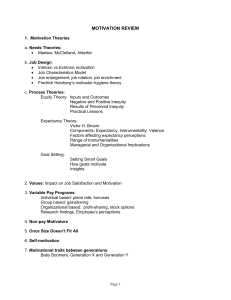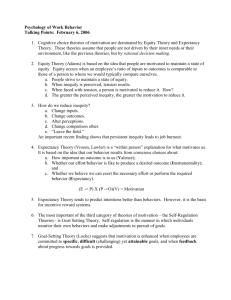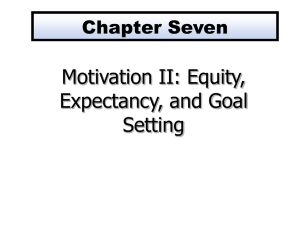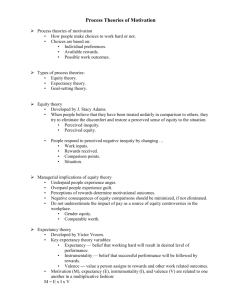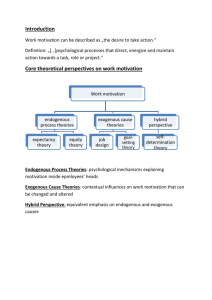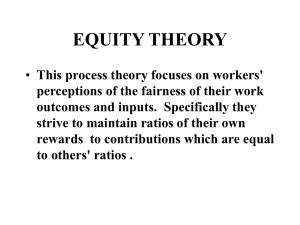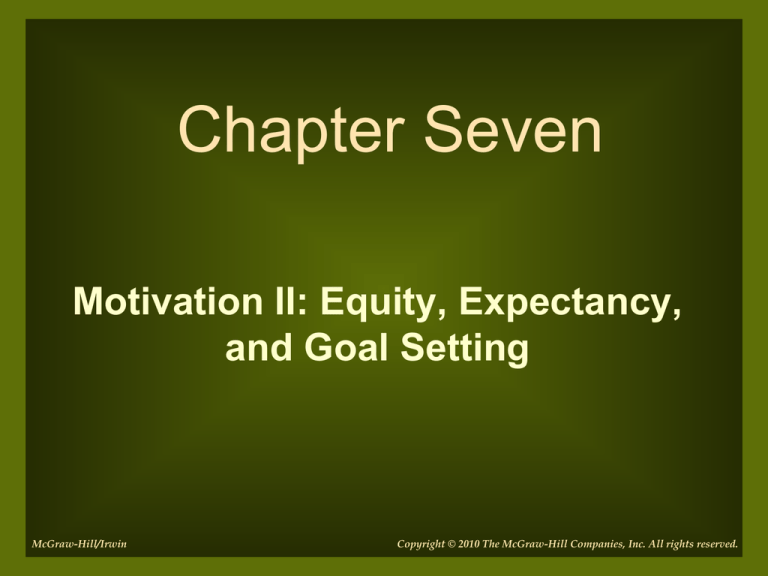
Chapter Seven
Motivation II: Equity, Expectancy,
and Goal Setting
McGraw-Hill/Irwin
Copyright © 2010 The McGraw-Hill Companies, Inc. All rights reserved.
After reading the material in this chapter,
you should be able to:
• Discuss the role of perceived inequity in
employee motivation.
• Describe the practical lessons derived from
equity theory.
• Explain Vroom’s expectancy theory.
• Describe the practical implications of expectancy
theory.
• Identify five practical lessons to be learned from
goal-setting research.
• Specify issues that should be addressed before
implementing a motivational program.
7-2
Equity Theory
• Equity theory
- Holds that
motivation is a
function of fairness
in social exchanges
7-3
The Individual-Organization
Exchange Relationship
• An employee’s inputs, for which he
expects a just return, include
education/training, skills, creativity,
seniority, age, personality traits, effort
expended, and personal appearance.
7-4
The Individual-Organization
Exchange Relationship
• On the outcome side the organization
provides such things as pay/bonuses,
fringe benefits, challenging assignments,
job security, promotions, status symbols,
recognition, and participation in important
decisions.
7-5
Negative and Positive Inequity
• Negative inequity
- Comparison in which another person receives
greater outcomes for similar inputs.
• Positive inequity
- Comparison in which another person receives
lesser outcomes for similar inputs.
7-6
Dynamics of Perceived Inequity
1. People have varying sensitivities to
perceived equity and inequity
2. Inequity can be reduced in a variety of
ways
7-7
Negative and Positive Inequity
Figure 7-1
7-8
Thresholds of Equity and Inequity
• Equity sensitivity
- An individual’s
tolerance for
negative and
positive equity
7-9
Thresholds of Equity and Inequity
• Benevolents
- people who have a higher tolerance for negative
inequity prefer their outcome/input ratio to be lower
than ratios from comparison others
• Sensitives
- adhere to a strict norm of reciprocity and are quickly
motivated to resolve both negative and positive
inequity
7-10
Thresholds of Equity and Inequity
• Entitleds
- have no tolerance for negative inequity
- expect to obtain greater output/input ratios
than comparison others and become upset
when this is not the case.
7-11
Organizational Justice
• Distributive justice
- The perceived fairness of how resources and
rewards are distributed.
• Procedural justice
- The perceived fairness of the process and
procedures used to make allocation decisions.
• Interactional justice
- Extent to which people feel fairly treated when
procedures are implemented.
7-12
Question?
Employees at Globe Trade have always felt
that resources and rewards are allocated
unfairly at work. Such employee
perceptions reflect _________.
A.
B.
C.
D.
Distributive justice
Interpersonal justice
Equitable justice
Procedural justice
7-13
Practical Lessons from Equity Theory
• Employees are more likely to accept and
support organizational change when they
believe it is implemented fairly and when it
produces equitable outcomes.
• Managers can promote cooperation and
teamwork among group members by
treating them equitably.
7-14
Practical Lessons from Equity Theory
• Treating employees inequitably can lead to
litigation and costly court settlements.
• Employees’ perceptions of justice are
strongly influenced by the leadership
behavior exhibited by their managers
• Managers should pay attention to the
organization’s climate for justice
7-15
Question?
At work, if Jamal's outcome to input ratio is
greater than that of Tony's (his relevant coworker), Jamal will experience
A. Equity.
B. No satisfaction.
C. Positive inequity.
D. High dissatisfaction.
7-16
Expectancy Theory of Motivation
• Expectancy theory
- Holds that people
are motivated to
behave in ways that
produce valued
outcomes.
7-17
Vroom’s Expectancy Theory
• Motivation boils down to the decision of
how much effort to exert in a specific task
situation.
• Expectancy
- Belief that effort leads to a specific level of
performance.
7-18
Expectancy
The following factors influence an
employee’s expectancy perceptions:
- Self-esteem.
- Self-efficacy.
- Previous success at the task.
- Help received from others.
- Information necessary to complete the task.
- Good materials and equipment to work with
7-19
Vroom’s Expectancy Theory
• Instrumentality
- A performance outcome perception
• Valence
- The value of a reward or outcome
• Outcomes
- refer to different consequences that are
contingent on performance
7-20
Question?
Niles believes that he will be promoted if he
meets his sales goals. This is his
___________ perception.
A. Expectancy
B. Instrumentality
C. Valence
D. Outcome
7-21
Managerial and Organizational
Implications of Expectancy Theory
7-22
Managerial and Organizational
Implications of Expectancy Theory
• Some workers value interesting work and
recognition more than money
• Extrinsic rewards can lose their motivating
properties over time and may undermine
intrinsic motivation
7-23
Question?
Dana believes in designing challenging jobs
for her employees. This is an implication of
_________ theory.
A. Equity
B. Motivation
C. Expectancy
D. Reinforcement
7-24
Prerequisites to Linking
Performance and Rewards
1. Managers need to develop and
communicate performance standards to
employees
2. Managers need valid and accurate
performance ratings with which to
compare employees
7-25
Prerequisites to Linking
Performance and Rewards
3. Managers need to determine the relative
mix of individual versus team contribution
to performance and then reward
accordingly
4. Managers should use the performance
ratings to differentially allocate rewards
among employees
7-26
Goals: Definition and Background
• Goal
- what an individual is trying to accomplish
• Management by objectives
- management system incorporating
participation in decision making, goal setting,
and feedback
7-27
How Does Goal Setting Work
• Goals direct attention
• Goals regulate effort
• Goals increase persistence
• Goals foster the development and
application of task strategies and action
plans
7-28
Insights from Goal-Setting Research
1. Difficult goals lead to higher performance
2. Specific, difficult goals lead to higher
performance for simple rather complex
tasks
•
Goal specificity – quantifiability of a goal
3. Feedback enhances the effect of
specific, difficult goals
7-29
Insights from Goal-Setting Research
4. Participative goals, assigned goals, and
self-set goals are equally effective
5. Goal commitment and monetary
incentives affect goal-setting outcomes
•
Goal commitment – extent to which an
individual is personally committed to
achieving a goal
7-30
Question?
Julia wants to become a successful heart
surgeon. This reflects Julia's
A.
B.
C.
D.
Expectancy
Perception
Goal
Personality
7-31
Relationship between Goal Difficulty
and Performance
Figure 7-2
7-32
Practical Application of Goal Setting
Step 1: Set goals
Step 2: Promote goal commitment
Step 3: Provide support
and feedback
7-33
Guidelines for Writing SMART Goals
7-34
Question?
Jim is the manager of a sales team at Woo
Automotive. He expects his salespeople to
sell 250 cars per week. Which guideline for
writing SMART goals does this violate?
A. Specific
B. Measurable
C. Attainable
D. Time-bound
7-35
Managerial Actions for
Enhancing Goal Commitment
1. Provide valued outcomes for goal
accomplishment.
2. Raise employees’ self-efficacy about
meeting goals by:
a) Providing adequate training
b) Role modeling desired behaviors and actions
c) Persuasively communicating confidence in the
employees ability to attain the goal
7-36
Managerial Actions for
Enhancing Goal Commitment
3. Have employees make a public
commitment to the goal.
4. Communicate an inspiring vision and
explain how individual goals relate to
accomplishing the vision.
5. Allow employees to participate in setting
the goals.
7-37
Managerial Actions for
Enhancing Goal Commitment
6. Behave supportively rather than
punitively.
7. Break a long-term goal (i.e., a yearly
goal) into short-term sub-goals.
8. Ensure that employees have the
resources required to accomplish the
goal.
7-38
Supplemental Slides
• Slides 36-40 contain extra non-text
examples to integrate and enhance
instructor lectures
-
Slide 36: A General Model of Expectancy Theory
Slides 37: Expectancy Theory Application
Slide 38: Goal Setting
Slide 39: Movie Example: Mr. Holland’s Opus
Slide 40: Video discussion slide
7-39
A General Model of Expectancy Theory
Outcome 1
Performance
High Effort
Decision
To Exert
Goal
Expectancy:
“What are my
chances of
reaching my
goal if I work
hard?”
Outcome 3
Effort
Low Effort
Outcome 2
Expectancy:
“What are my
chances of
reaching my goal
if I slack off?”
Instrumentality:
“What are my
chances of getting
various outcomes if
I achieve my goal?
Valence: “How
much do I value
these
outcomes?”
Outcome 1
Outcome 2
Performance
Goal
Outcome 3
7-40
Expectancy Theory Application
• STEP 1 Valence represents the value placed on outcomes.
Calculate the valence for all levels of performance. The
equation is:
• Performance Valence = [(Instrumentality1 x Valence1) + (I2
x V2) + (I3 x V3) + … (In x Vn)]
• STEP 2 Calculate the force on an individual to exert
different levels of effort. Force represents the strength of an
individual’s intention to respond in a particular manner. The
equation is:
• Force = the sum of [Expectancy x Performance Valence] for
all levels of performance associated with one level of effort.
• STEP 3 Compare force values for each performance level.
7-41
Goal Setting
Read an article by
Latham and Locke on
“Goal Setting-A
Motivational
Technique that Works”
7-42
Movie Example: Mr. Holland’s Opus
As a manager, is it
important for
Principal Jacobs to
know the
motivations of her
subordinates?
7-43
Video Case: Hot Topic
• What unique features does the culture at Hot
Topic have? How do these features contribute
to their success?
• What benefits do you like that are offered by Hot
Topic? Are they different than the benefits you
have heard about from your parents or others?
• How does Hot Topic keep itself current with
what its customers and employees want?
7-44
Video Case: Motivation Convention
• Are people fundamentally different today than in
the past? Why do workers need to be “buttered
up” more today?
• What are some different types of incentives
employees are given today to “motivate” them?
What have you received in terms of different
incentives from your employers?
• Why is motivating employees so important - do
you think it makes that big of a difference?
7-45

